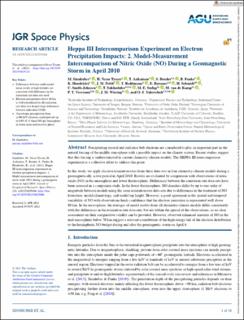| dc.contributor.author | Sinnhuber, M. | |
| dc.contributor.author | Tyssøy, Hilde Nesse | |
| dc.contributor.author | Asikainen, T. | |
| dc.contributor.author | Bender, Stefan | |
| dc.contributor.author | Funke, B. | |
| dc.contributor.author | Hendrickx, K. | |
| dc.contributor.author | Pettit, J.M. | |
| dc.contributor.author | Reddmann, T. | |
| dc.contributor.author | Rozanov, E. | |
| dc.contributor.author | Schmidt, H. | |
| dc.contributor.author | Smith-Johnsen, Christine | |
| dc.contributor.author | Sukhodolov, T. | |
| dc.contributor.author | Szeląg, M.E. | |
| dc.contributor.author | van de Kamp, de | |
| dc.contributor.author | Verronen, P.T. | |
| dc.contributor.author | Wissing, J.M. | |
| dc.contributor.author | Yakovchuk, O.S. | |
| dc.date.accessioned | 2023-01-06T12:35:55Z | |
| dc.date.available | 2023-01-06T12:35:55Z | |
| dc.date.created | 2022-04-27T15:30:40Z | |
| dc.date.issued | 2022 | |
| dc.identifier.issn | 2169-9380 | |
| dc.identifier.uri | https://hdl.handle.net/11250/3041588 | |
| dc.description.abstract | Precipitating auroral and radiation belt electrons are considered to play an important part in the natural forcing of the middle atmosphere with a possible impact on the climate system. Recent studies suggest that this forcing is underestimated in current chemistry-climate models. The HEPPA III intercomparison experiment is a collective effort to address this point.
In this study, we apply electron ionization rates from three data-sets in four chemistry-climate models during a geomagnetically active period in April 2010. Results are evaluated by comparison with observations of nitric oxide (NO) in the mesosphere and lower thermosphere. Differences between the ionization rate data-sets have been assessed in a companion study. In the lower thermosphere, NO densities differ by up to one order of magnitude between models using the same ionization rate data-sets due to differences in the treatment of NO formation, model climatology, and model top height. However, a good agreement in the spatial and temporal variability of NO with observations lends confidence that the electron ionization is represented well above 80 km. In the mesosphere, the averages of model results from all chemistry-climate models differ consistently with the differences in the ionization-rate data-sets, but are within the spread of the observations, so no clear assessment on their comparative validity can be provided. However, observed enhanced amounts of NO in the mid-mesosphere below 70 km suggest a relevant contribution of the high-energy tail of the electron distribution to the hemispheric NO budget during and after the geomagnetic storm on April 6. | en_US |
| dc.language.iso | eng | en_US |
| dc.publisher | American Geophysical Union | en_US |
| dc.rights | Navngivelse-Ikkekommersiell 4.0 Internasjonal | * |
| dc.rights.uri | http://creativecommons.org/licenses/by-nc/4.0/deed.no | * |
| dc.title | Heppa III Intercomparison Experiment on Electron Precipitation Impacts: 2. Model-Measurement Intercomparison of Nitric Oxide (NO) During a Geomagnetic Storm in April 2010 | en_US |
| dc.title.alternative | Heppa III Intercomparison Experiment on Electron Precipitation Impacts: 2. Model-Measurement Intercomparison of Nitric Oxide (NO) During a Geomagnetic Storm in April 2010 | en_US |
| dc.type | Journal article | en_US |
| dc.type | Peer reviewed | en_US |
| dc.description.version | publishedVersion | en_US |
| dc.rights.holder | Copyright 2021 the authors | en_US |
| dc.source.articlenumber | e2021JA029466 | en_US |
| cristin.ispublished | true | |
| cristin.fulltext | original | |
| cristin.qualitycode | 2 | |
| dc.identifier.doi | 10.1029/2021JA029466 | |
| dc.identifier.cristin | 2019600 | |
| dc.source.journal | Journal of Geophysical Research (JGR): Space Physics | en_US |
| dc.relation.project | Norges forskningsråd: 302040 | en_US |
| dc.relation.project | Norges forskningsråd: 223252 | en_US |
| dc.identifier.citation | Journal of Geophysical Research (JGR): Space Physics. 2022, 127 (1), e2021JA029466. | en_US |
| dc.source.volume | 127 | en_US |
| dc.source.issue | 1 | en_US |

